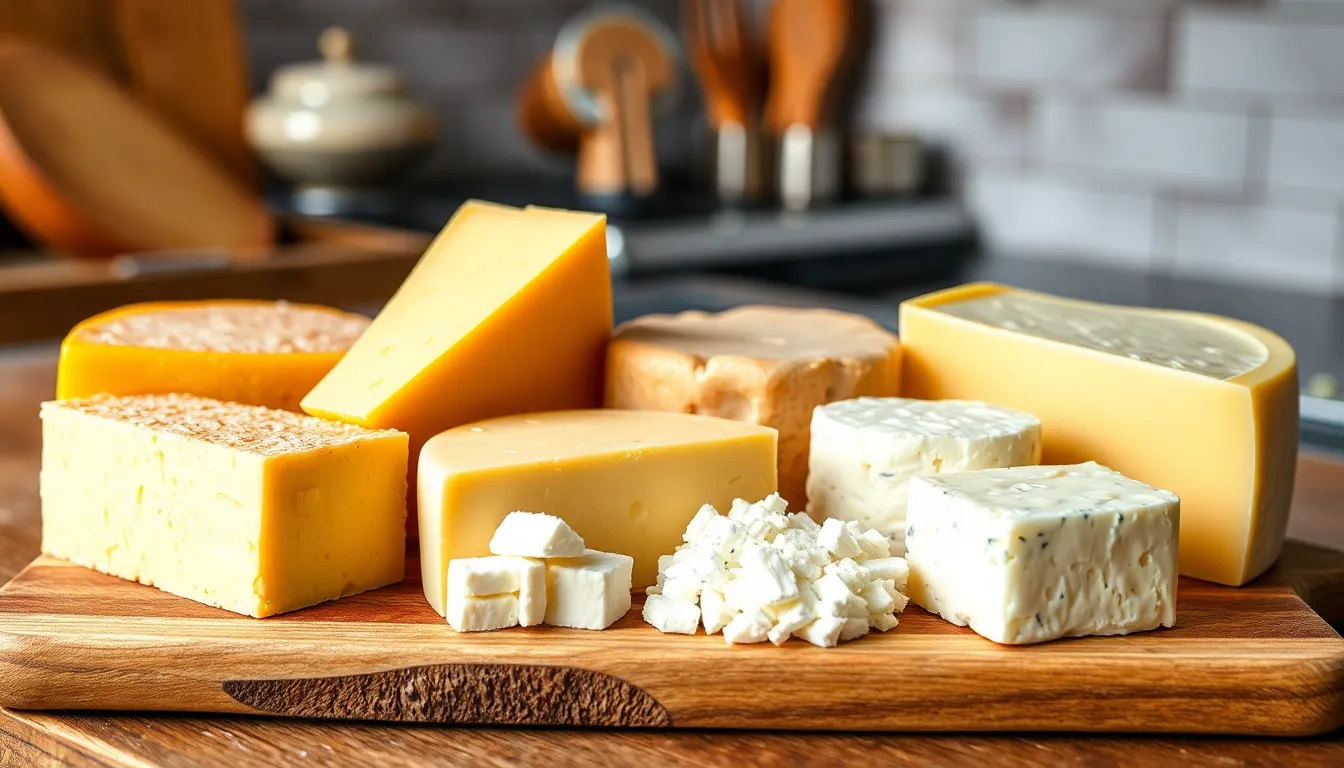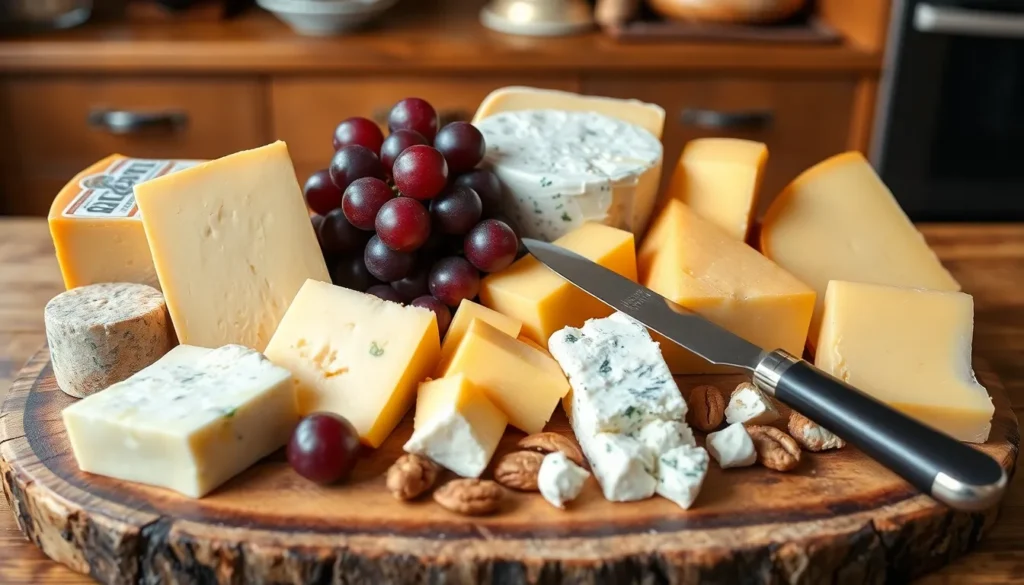Cheese lovers rejoice! If you’ve ever wondered which cheese packs the most protein, you’re in for a treat. It’s time to elevate your cheese game and turn your snack into a protein powerhouse. Forget about boring protein bars—why not indulge in a creamy, delicious slice of cheese instead?
While some may think of cheese as just a guilty pleasure, the right choice can turn your cheesy cravings into a guilt-free delight. From savory snacks to gourmet meals, certain cheeses can help you hit those protein goals without sacrificing flavor. So grab your crackers and let’s explore which cheese reigns supreme in the protein department. Who knew that munching on cheese could be both tasty and nutritious?
Table of Contents
ToggleOverview of Cheese Varieties
Cheese presents a wide array of options, each with unique flavors and nutritional profiles. Different types of cheese can cater to diverse tastes and dietary needs. Understanding these varieties helps in selecting the right cheese for optimal protein content.
Hard Cheeses offer some of the highest protein levels. Examples include Parmesan and Grana Padano, both containing about 30 grams of protein per 100 grams. Cheddar, another popular hard cheese, has around 25 grams of protein per 100 grams, making it a great snack option for protein seekers.
Semi-Hard Cheeses also contribute significantly to daily protein intake. Gouda, with approximately 25 grams of protein per 100 grams, serves as a flavorful addition to various dishes. Edam, similar in protein level, enhances salads and sandwiches while providing nutritional benefits.
Soft Cheeses generally contain less protein than their hard counterparts. However, options like cottage cheese stand out, providing nearly 11 grams of protein per 100 grams, which makes it a nutritious choice for breakfast or snacks. Feta offers around 14 grams of protein per 100 grams while adding zest to salads and Mediterranean dishes.
Fresh Cheeses, such as ricotta, provide a gentler flavor profile and moderate protein content. Ricotta has approximately 11 grams of protein per 100 grams, making it suitable for desserts and savory recipes. Cream cheese, while creamier, contains around 7 grams of protein per 100 grams and is typically used in spreads and dips.
Ultimately, selecting the right cheese depends on personal taste preferences and nutritional goals. Balancing flavor and protein content can enhance any diet while enjoying the diverse world of cheese.
Nutritional Content of Cheese

Cheese serves as a flavorful source of protein and other essential nutrients. Different varieties provide varying levels of protein and additional nutritional benefits.
Protein Content Comparison
Parmesan leads with around 35 grams of protein per 100 grams. Cheddar follows closely with about 25 grams, while Gouda offers approximately 26 grams. Feta has lower protein levels, contributing around 14 grams, and cottage cheese provides roughly 11 grams. Each cheese type supports a distinctive protein profile, appealing to diverse dietary needs. When selecting a cheese, it’s helpful to consider these protein values for better meal planning.
Other Nutritional Factors
Calcium stands out as a primary benefit of cheese, essential for strong bones and teeth. A 100-gram serving of Parmesan contains about 1184 mg of calcium, while Cheddar holds around 721 mg. Vitamin B12 also prominently appears in cheese, aiding in energy metabolism. Additionally, many cheeses contain beneficial fats that support overall health. When considering cheese options, awareness of sodium levels is crucial since some varieties contain high amounts, which may impact health.
Top High-Protein Cheeses
Certain cheeses stand out for their high protein content. Here’s a closer look at some of the top contenders.
Cottage Cheese
Cottage cheese contains about 11 grams of protein per 100 grams. This soft, mild cheese offers versatility in dishes, pairing well with fruits and salads. It’s also lower in fat, making it a popular choice for those monitoring calorie intake. Many people incorporate cottage cheese into smoothies, providing a creamy texture that enhances flavor while boosting protein levels.
Parmesan Cheese
Parmesan cheese tops the protein charts with around 35 grams of protein per 100 grams. Aged and hard, this cheese boasts a rich flavor that intensifies when grated over dishes. Often used in Italian cuisine, it complements pastas, soups, and salads. Nutritionally dense, Parmesan also supplies calcium and B vitamins, making it both nutritious and tasty.
Grana Padano
Grana Padano features approximately 30 grams of protein per 100 grams. This semi-hard cheese, similar to Parmesan, carries a slightly nutty flavor profile. It’s versatile in the kitchen, suitable for grating, slicing, or enjoying on its own. Rich in nutrients, Grana Padano also provides essential minerals while offering a delightful taste experience.
Gouda Cheese
Gouda cheese provides around 26 grams of protein per 100 grams. Known for its creamy texture and sweet, nutty flavor, Gouda enhances various dishes. It melts excellently, making it a favorite for grilled cheese sandwiches and fondues. Nutritionally, it includes calcium and beneficial fatty acids, promoting overall health along with a satisfying taste.
Factors Influencing Protein Levels in Cheese
Protein levels in cheese depend on several factors. Understanding these factors helps in selecting the best cheese options for protein intake.
Milk Type
Milk type plays a crucial role in determining the protein content of cheese. Cow’s milk typically contains higher protein levels compared to goat or sheep milk. Cheese made from skim milk retains more protein due to the reduced fat content while maintaining a concentrated protein ratio. Hard cheeses commonly use cow’s milk, providing up to 35 grams of protein per 100 grams. Whole milk cheeses, on the other hand, contain more fat, which can slightly lower protein levels. Additionally, the breed of the animal can influence protein variation, with certain breeds producing milk richer in protein.
Cheese Processing Methods
Cheese processing methods significantly influence protein preservation and concentration. Heating milk during pasteurization may affect protein structure, impacting its nutritional quality. Curd formation through rennet or acid addition solidifies protein, concentrating it as moisture is removed. Aging processes also affect protein composition, as some proteins break down into amino acids. Hard cheeses like Parmesan undergo longer aging times, enhancing protein concentration. Moreover, manufacturing processes that involve reducing moisture content yield products higher in protein, making them denser in nutrition.
Cheese is an excellent choice for those looking to boost their protein intake while enjoying a tasty snack. With options ranging from hard cheeses like Parmesan and Cheddar to softer varieties like cottage cheese and feta, there’s a cheese for every palate and dietary need.
Incorporating high-protein cheeses into meals not only enhances flavor but also provides essential nutrients like calcium and Vitamin B12. By understanding the protein content and nutritional profiles of different cheeses, individuals can make informed choices that align with their health goals.
Embracing cheese as a protein-rich snack can transform meal planning and elevate everyday eating experiences.









